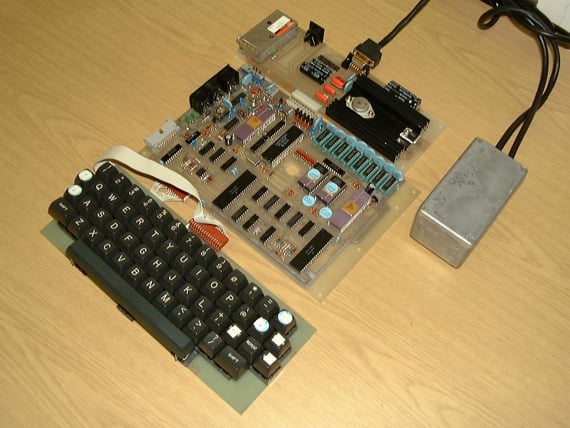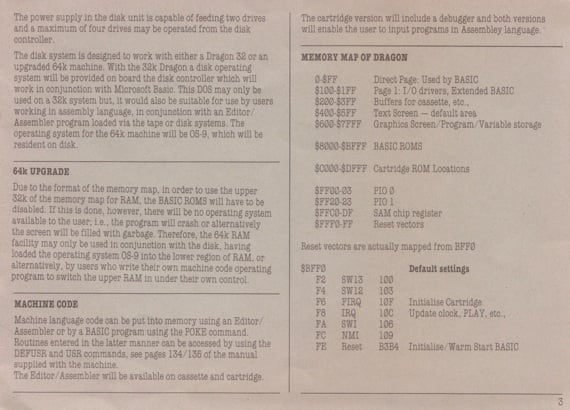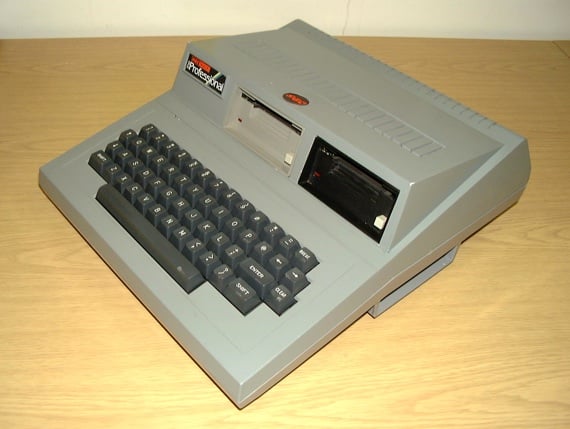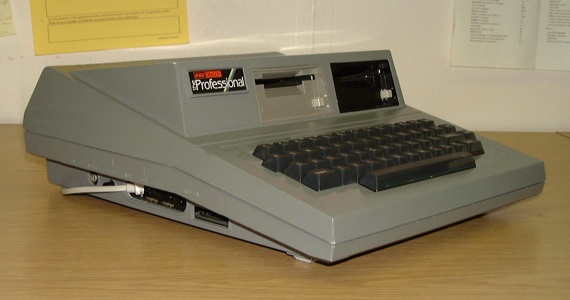Original URL: https://www.theregister.com/2012/08/01/the_dragon_32_is_30_years_old/
The Dragon 32 is 30
Fire starter
Posted in Personal Tech, 1st August 2012 07:00 GMT
Archaeologic The Dragon 32, arguably the best-known and most-successful of the UK's early 1980s home computer also-rans, was introduced 30 years ago this month.
The micro's story goes back more than a year before its launch. Tony Clarke, a senior manager at Swansea-based toy company Mettoy - best known for its Corgi die-cast metal car brand - had witnessed the arrival of the Acorn Atom, the Sinclair ZX81 and the Commodore Vic-20, and noticed kids' growing interest in the new technology. He sensed a fresh opportunity for Mettoy, a firm founded back in the 1930s.
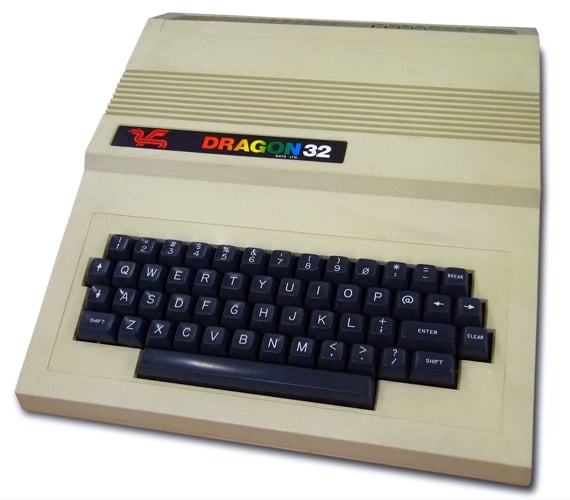
Would-be saviour of the UK toy industry
Source: Wikimedia
Children were soon going to be turning to computers for play, Clarke reasoned, and that would move them away from more traditional toys, Mettoy's mainstay. Mettoy had, then, to move with the times and break into the home computer business.
To that end, Clarke initiated 'Project Sam' in the Autumn of 1981. He approached the PA Technology (PAT) of Cambridge - part of PA Consulting - to design a new microcomputer. Appreciating the fast-moving nature of the computer business, Clarke gave the PAT team, headed by Ian Thompson-Bell, a tight deadline. That, Thompson-Bell would admit the following year, forced the team to select an off-the-shelf Basic interpreter; there wasn't time to write one of their own.
The obvious choice back then for a buy-in Basic was Microsoft, and that selection immediately limited the range of possible processors the new micro could use. Thompson-Bell and his team selected the Motorola 6809, unquestionably a better processor than the 6502 and Z80A, but, more importantly, one readily available with a set of Motorola support chips: the 6883 Synchronous Address Multiplexer (SAM) memory controller, and the 6847 video controller.
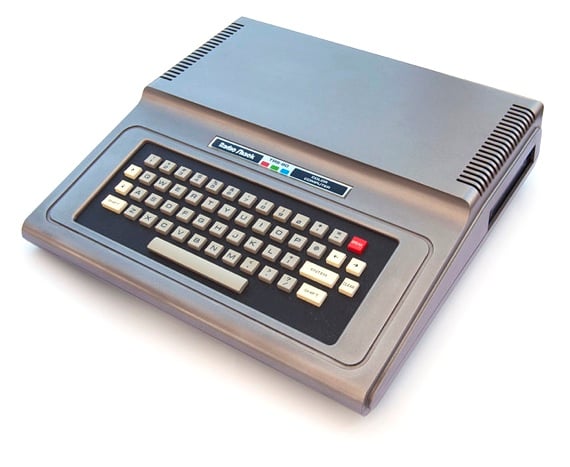
The reference design? Tandy's TRS-80 CoCo
Source: Wikimedia
With those products, said Thompson-Bell at the time, "you have virtually a home computer in three chips". PAT also fitted two of Motorola's 6821 Peripheral Interface Adaptor (PIA) chips to handle the machine's I/O.
It helped that Tandy had paved the way. The US manufacturer launched the 6809-based TRS-80 Color Computer in 1980. The 'CoCo', as it was affectionately named, was certainly available in the UK at the time the Dragon was being developed, but wasn't well known by Britain's new generation of young computer enthusiasts, not least because of it was only available in Tandy shops and cost a whopping £499.
Tandy had created the CoCo as a games-centric home machine to compete with Commodore's Vic-20. Tandy, as Dragon would later, chose Microsoft Basic and turned to Motorola - then keen to break into the booming US home computer market - to provide the machine's off-the-shelf, ready-to-use components and reference designs.
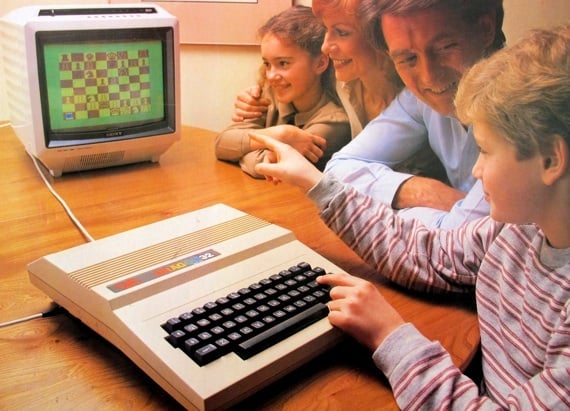
Family friendly: Dragon 32 promo pic, later used for box art
It has been claimed that PAT simply aped the CoCo, but that seems unlikely. A more plausible scenario is that reliance on the silicon and reference designs eagerly provided by Motorola ensured that the Dragon and the CoCo were always going to be effectively the same machine, cosmetic and minor specification differences aside. Machine code programs were interchangeable, for example.
The Motorola factor
But software written in Basic wouldn't run straight off the tape because the two machines used different tokens to represent Basic keywords. And while Tandy had selected Microsoft's entry-level Color Basic, the PAT team chose an extended version with a broader array of graphics modes and other features.
PAT also contracted assembly language specialist Duncan Smeed of the University of Strathclyde, Glasgow to work on the new machine's Bios. Motorola had a strong presence in Scotland. Its UK semiconductor operation was based in East Kilbride, south of Glasgow. It still is, though the business, spun out of Motorola in 2004, is now called Freescale.
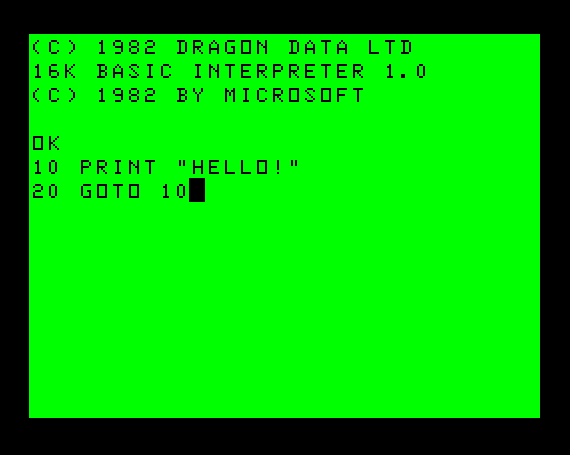
Basic programming
Smeed took the stock Motorola Bios and proceeded to tweak it for the hardware changes PAT was making to the reference designs. Smeed also made numerous optimisations, for instance recoding the keyboard scanning routines - a vital part of a system operated through Basic - to yield a 10-15 per cent performance jump over the reference hardware and the CoCo. The Bios assembly code was prepared on the University's DEC PDP-11 and then burnt to EEProm at Motorola.
He craftily dropped his initials, 'DNS' into the Bios' six-byte end-of-line sequence. Only the first two bytes of the six, Carriage Return and Line Feed are used, unless you poke an address with a '6' instead of a '2', in which case Duncan's initials print out on every line. Smeed hand-burned the code, not included in the Bios source print-out, into the final version EEProms
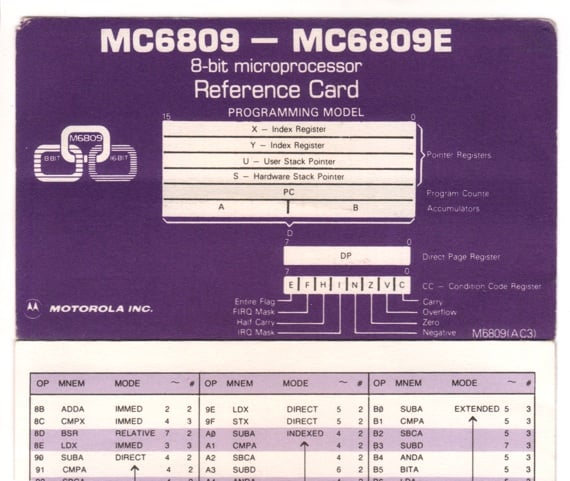
Motorola reveals the 6809E's basics
Smeed would leave Strathclyde in 1983 to join Dragon Data as its Systems Software Manager. He returned to academia in 1986, a year after leaving Dragon, and today he is once again teaching computer science at the University.
PAT would further differentiate Dragon's hardware from Tandy's by adding a parallel printer port in place of the CoCo's serial connector. The video chip was adjusted for 625-line PAL output rather than the US-standard 525-line NTSC. How much of this adjustment was done merely to avoid invidious comparisons between the Dragon and the CoCo, or was a genuine attempt to take a stock design and make a better will probably never be known.
As Smeed now recalls: "There were three drivers behind the Dragon's early development: time to market, time to market, time to market."

From Risc to risque: Motorola's 6809E command set prompted many a schoolboy snigger
The pressure was on to get the kit out and get it out very quickly. In those circumstance, developers have to take any shortcut they're offered.
The prototype Dragon, fitted with 16KB of memory and codenamed 'Pippin', was completed in November 1981, allowing Tony Clarke to show the PAT team's work to the Mettoy board and so gain its approval to put the computer into production.
Pippin but no togs
At that stage, Pippin consisted of little more than a motherboard wired up to a keyboard, but it was sufficiently complete for Richard Wadman, Clarke's marketing manager, to begin promoting the micro to journalists and to potential software developers. Wadman would go on to write the Dragon's Basic programming manual.
The Mettoy board approved Clarke's plan, and PAT was asked to oversee the initial production run. Newport-based Race Electronics was contracted to manufacture the first batch of Dragons.
It's unclear quite when Race began punching out machines. However, after production had begun, it was decided by Clarke, now head of Mettoy subsidiary Dragon Data, that the machine would need to ship with 32KB of memory, double that designed into the prototype.
It is said that the change was prompted by the arrival of the 16KB and 48KB Sinclair Spectrum, both of which were cheaper than the Dragon's planned £200 price point. Undoubtedly, Clarke figured the Dragon's full-size keyboard and tough plastic case would make the premium over the £175 48KB Spectrum seem reasonable, but not if the Dragon only shipped with 16KB. Doubling the amount of Ram would also help the Dragon compete with the BBC Micro, by early 1982, also on the market.
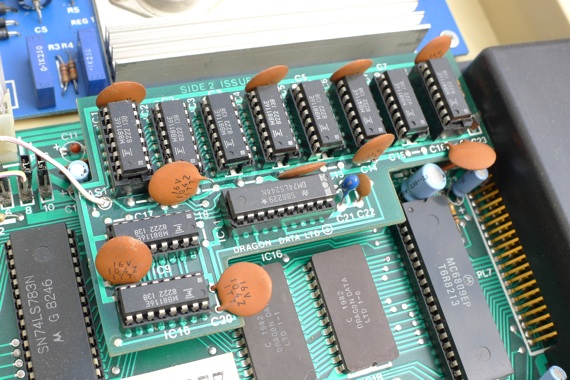
More Ram, please. Designed for 16KB, early Dragons gained an extra 16kB daughtercard before release
PAT's motherboard layout wouldn't accept the extra Ram chips, so the first 10,000 machines, the initial production run, all required a 16KB daughter card to be fitted and wired up to the main board.
The author's Dragon 32 - purchased for Christmas 1982 - contains board number 9977 complete with "piggy-back" memory board.
Microsoft's Basic code didn't incorporate lower-case letters: these appeared on screen as reverse-video capitals, though they printed correctly through the not-quite-standard "Centronics-type" parallel port.
The Dragon 32 supported the customary video output through a TV modulator, but it also had a composite video five-pin Din port for a monitor. Other Din ports were used for the two analogue joystick connectors, and for the obligatory cassette I/O. The Dragon had a Rom cartridge slot that filled 8KB of the 64KB memory map.
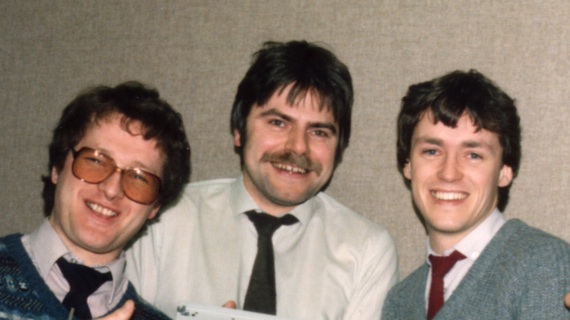
Members of Dragon Data's 1983 R&D team: (L-R) Duncan Smeed, Jan Wojna and John Linney
Picture taken in 1985 after they had joined Thorn EMI
64KB? Yes, the Dragon's memory map was plotted across that full range. Only the first 32KB was mapped onto the Ram chips, after which came the 16KB Rom chip then the Rom cartridge allocation - preventing cartridges being hot-swappable - the PIA chip registers, the SAM chip registers, and eight bytes of reset vectors.
The belly of the Dragon
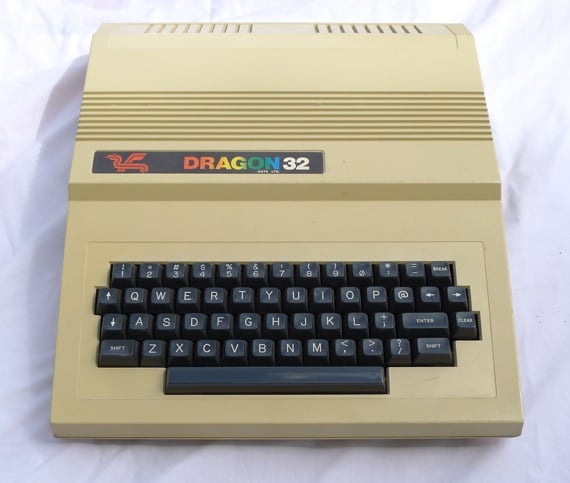
Lid on...
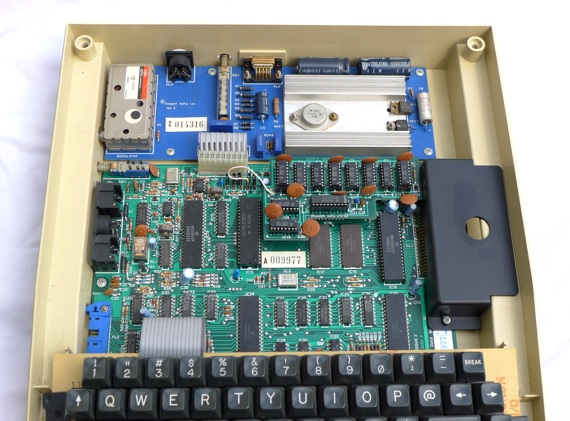
...lid off...
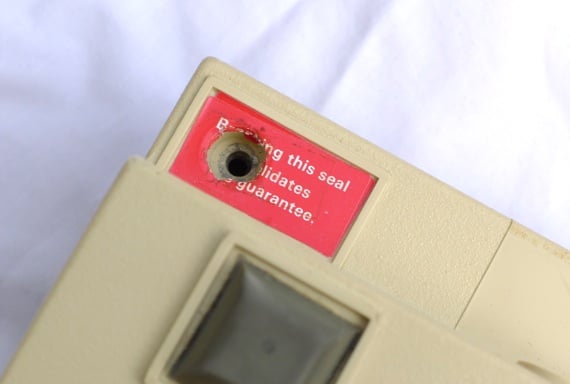
... but only after disobeying the warnings
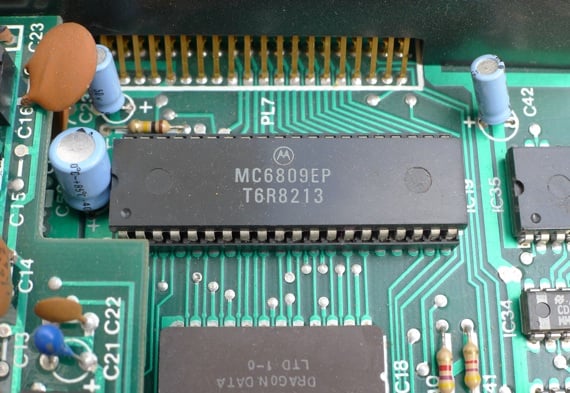
The Motorola 6809E - the finest 8-bit CPU. Accept no substitutes.
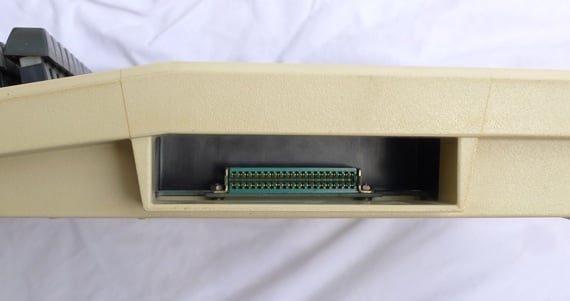
The Rom cartridge slot on the right side went directly into the Dragon 32's memory map
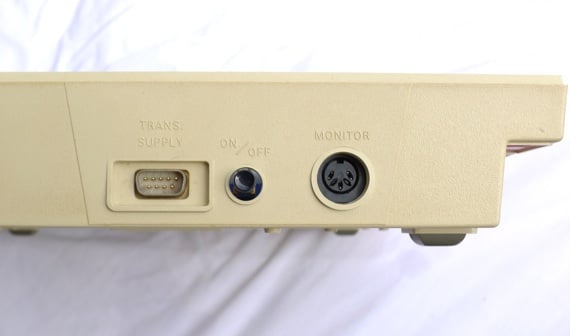
Before VGA there was... Dragon 32 AC adaptor feeds. And a Din port for composite video
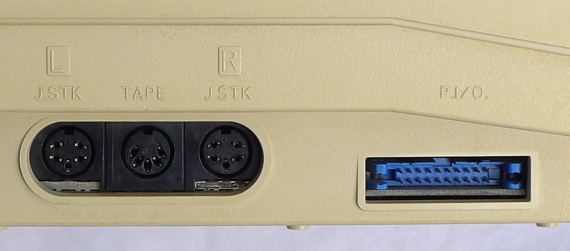
What a Din: the Dragon's three serial ports - joysticks and tape - and "Centronics-type" parallel port for printers
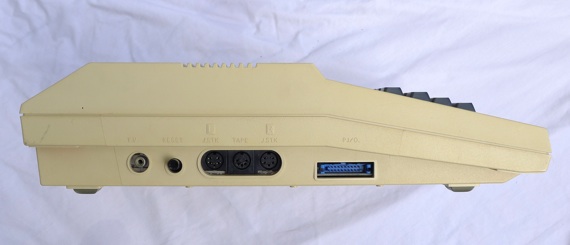
Completing the picture: the TV modulator port and the warm reset button
Financial woes
Before the launch of the Dragon 32, the PAT team began revising the design for a 64KB model, which was hinted at as a "64KB upgrade" in the Information for Machine Code Users booklet supplied with the Dragon. The booklet also promised a disk-resident "Unix-like OS-9" operating system for the 64KB machine and a disk drive package comprising a controller that plugged into the machine's cartridge slot.
While PAT was creating what would become the Dragon 64, Mettoy was running into financial difficulties. To save Dragon Data, in October 1982 Clarke engineered investments from the Welsh Development Agency (WDA), a governmental body; Prudential Insurance's VC wing, Pru-Tech; and others.
Dragon Data separated from Mettoy, which would soon go into administration, selling its remaining stake in Dragon to Pru-Tech. Mettoy managers bought the what was left of the company and relaunched it as Corgi. Corgi still survives, though it has had many different owners in the years since then, including US toy giant Mattel and, now, Chinese company Zindart.
But by April 1983, 40,000 Dragon 32s had been sold, many in the run-up to Christmas 1982. Dragon Data had moved to larger premises - in order to bring manufacturing in-house - at the behest of the WDA, and it was eyeing output of 5000 units a month and a launch in the US.
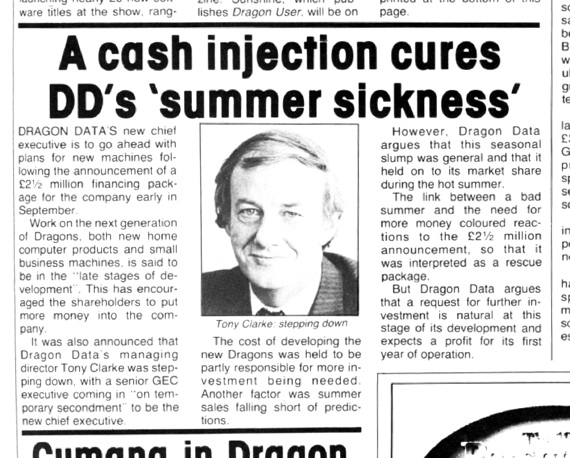
Founder out: Tony Clarke's departure, reported in Dragon User, October 1983
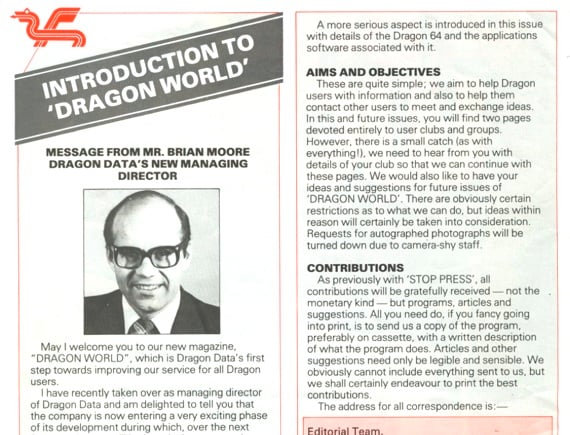
New MD in: Brian Moore introduces himself in Dragon World, December 1983
The following August, a year on from the Dragon 32's debut, Dragon Data announced the Dragon 64 with a view to beginning shipments the following month. By now, the company had signed up New Orleans-based Tano to produce and sell the 32KB and 64KB machines in the US, and if the Dragon 64 was arriving later than promised, the outlook seemed good to the machine's many fans.
But Dragon Data's sales projections were not being achieved. The company was struggling against Sinclair's Spectrum, Commodore's 64 and Acorn's BBC Micro. While the coming Christmas sales season promised to be fruitful, shareholders were increasingly voicing their criticism of Dragon Data's management.
In September 1983, founder Tony Clarke was ousted. Brian Moore was brought in from electronics company GEC - with which Pru-Tech had a strong relationship - on a temporary basis as Clarke's replacement. His job: to focus on tightening Dragon Data's operations and to build a viable basis for the company's future development. The move soon yielded a £2.5m investment from GEC, which had by now realised it needed to enter the home computer business.
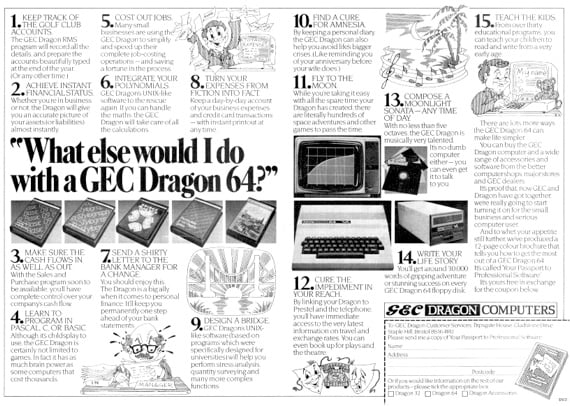
Dragon goes 64KB - and enters the GEC era
During 1984, GEC would tighten its hold on Dragon Data, first by taking on board the manufacturer's sales and marketing operations, and then by renaming the company GEC Dragon. It talked about a 64KB transportable with an on-board modem and a 3.5in Sony floppy drive. It pitched a dual-CPU machine, codenamed the Alpha and destined to be promoted as the Professional, with 256KB of Ram and two 3.5in floppy drives. The Alpha was based on the original Dragon case design, but a more PC-style unit, the Beta, was also created.
The next generation
Smeed worked on the Alpha, which was the focus of Dragon Data's small but eager R&D team - which included Jan Wojna, Andy Cash, John Linney and others - put in place early in 1983. The decision to use two processors arose because Motorola had more 6809Es than Dragon could buy. He and his team used one of the two CPUs as a DMA controller to speed up the machine's disk performance, essential for the I/O-dependent OS-9, from Microware, it was set to use.
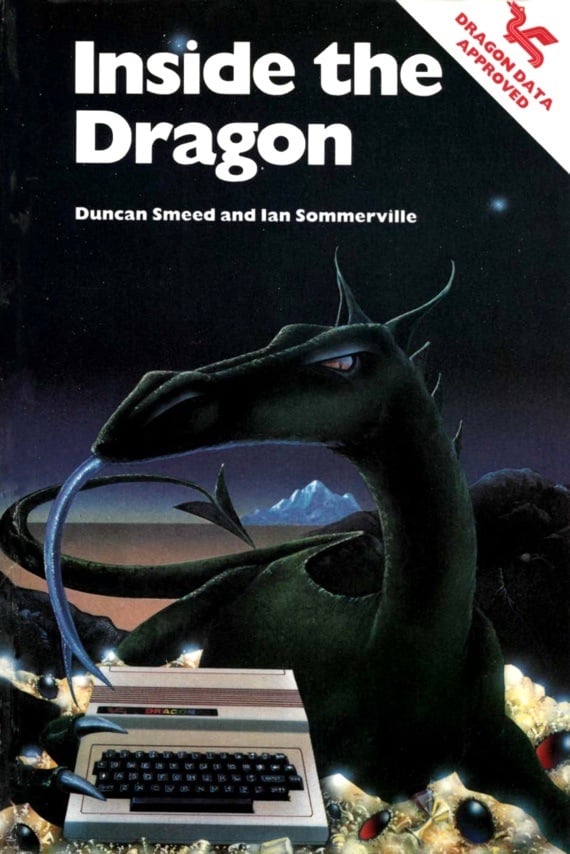
The Dragon hacker's bible
None of these machines made it to market, though GEC did begin pitching the Professional to the computer press for review coverage, saying a single-disk version would ship for £699, the two-disk model for £849. Reviews published around revealed that the machine was not ready for sale: it ran very hot and was rather temperamental - probably due to the heat.
In May 1984, GEC Dragon called in the receivers, blaming "the continuing difficulties of establishing profitable trading in the UK and other parts of the world".
The writing had been on the wall: 1982's Dragon 32, even upgraded to 64KB, had not fared well during Christmas 1983, going up now against cheaper machines, including the low-cost BBC Micro-compatible Acorn Electron, and even cheaper 48KB Spectrum and the 1983-released Oric 1. Early sales success led to over-optimistic projections of the numbers of Dragons that could be sold in subsequent years. Supply outstripped demand.
Boots, one of the first major retailers to take on the Dragon, indicated in the spring of 1984 that it would stop selling the machine. British Home Stores, another early supporter, had actually gone ahead and done so.
Potential buyers lined up, among them Philips, GEC itself and - ironically - Tandy. In the end, a deal with Spain's Eurohard was brokered which would see the Spanish firm acquire all of the GEC Dragon's assets, with GEC handling UK sales and marketing, and a new firm, Touchmaster, handling after-sales support and peripheral sales. Touchmaster was run by GEC Dragon's management and backed by Pru-Tech.
Duncan Smeed and a number of Dragon's R&D team joined the company's Technical Director, Derek Williams, and together went to Thorn EMI to work on a mobile computer, the Liberator.
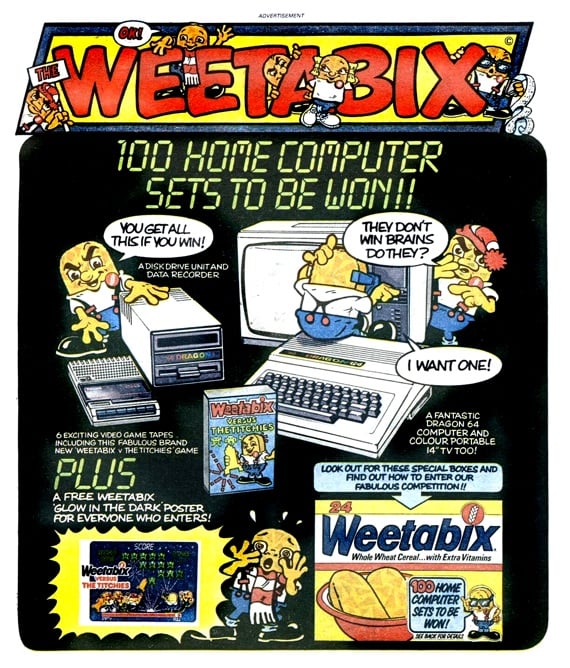
Even Weetabix couldn't save Dragon
Source: combomphotos/Flickr
Meanwhile, Eurohard promised much, but failed to revive the Dragon's fortunes. It sold too few of the stock acquired in the GEC Dragon firesale to fund the ambitious expansion plans it discussed with journalists and Dragon fans. Its demise was drawn out, but certain.
Time had left the Dragon behind. Christmas 1984 would prove very tough for almost every micro maker. The microcomputer boom was over. The kids had their computers; adults were now after the next big thing, CD players. Even giants like Acorn and Sinclair struggled to stay clear of the wreckage. Dragon Data would have surely been crushed had it survived that long. ®
The author would like to thank the many retro-tech fans for archiving home computing adverts, photos and documentation from the 1980s and 1990s, without whom this feature would not be possible. Special thanks go to Duncan Smeed, Richard Harding of DragonData.co.uk and Simon Hardy of World of Dragon for their invaluable help.
